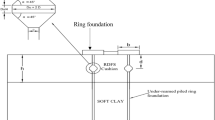Abstract
Various wastes have gained attention nowaday as they are widely used in stabilization of expansive soils. The construction–demolition waste has not been widely used in soil stabilization, and its use is still under research. A lot of construction–demolition waste is being produced from old dismantled buildings whose disposal is a major concern due to limited availability of land space. This paper presents a laboratory investigation using consolidated drained triaxial test in order to study the stress–strain and volumetric behavior, shear strength parameters, strength ratio at various strain levels and stiffness of un-stabilized as well as crushed construction–demolition waste (CCDW) stabilized soil. The test results revealed that the addition of CCDW in un-stabilized soil has improved its stress–strain and volumetric behavior remarkably, at all confining pressures. The volumetric strain has been found to be decreased with the addition of CCDW. The inclusion of CCDW in un-stabilized soil has decreased the cohesion value to a limited extent and increased the angle of shearing resistance significantly. An increase in strength ratio as well as the stiffness of un-stabilized soil has also been improved when it is stabilized with CCDW. In the end, a practical numerical example has been solved in order to make the readers understand the significance of the improvement in un-stabilized soil after incorporating CCDW into it. This mixture of CCDW-stabilized expansive soil can be used in construction of low-volume traffic roads and embankment stability.















Similar content being viewed by others
References
Phanikumar BR (2009) Expansive soils: problems and remedies. In: Indian geotechnical conference, Guntur, India, pp 907–913
Katti R (1980) Search for solutions for problems in black cotton soils. Indian Geotech J 9(1):1–80
Petry TM, Little DN (1992) Update on sulfate-induced heave in treated clays: problematic sulfate levels. Transport Res Rec 1362:51–55. https://doi.org/10.1001/archsurg.143.8.730
Brooks RM, Mehmet C (2012) Application of construction demolition waste for improving performance of subgrade and subbase layers. Int J Res Rev Appl Sci 12(3):375–381
Kerni V, Vinod KS, Umar J (2015) Review on stabilization of clayey soil using fines obtained from demolished concrete structures. Int J Innov Res Sci Eng Technol 4(5):296–299. https://doi.org/10.15680/IJIRSET.2015.0405106
Li Y, Hui Z, Linjian S, Hang H, Li D (2017) Investigation into the application of construction and demolition waste in urban roads. Adv Mater Sci Eng. https://doi.org/10.1155/2017/9510212
Vieira CS, Paulo MP (2015) Use of recycled construction and demolition materials in geotechnical applications: a review. Resour Conser Recyc 103:192–204. https://doi.org/10.1016/j.resconrec.2015.07.023
Henzinger C, Dirk H (2017) Soil improvement using recycled aggregates from demolition waste. Proc Inst Civ Eng Ground Improv 171:74–81. https://doi.org/10.1680/jgrim.17.00031
Dafalla MA (2013) Effects of clay and moisture content on direct shear tests for clay-sand mixtures. Adv Mater Sci Eng. https://doi.org/10.1155/2013/562726
Ma SK, Mao SH, Ping H, Chao Y (2013) Soil–water characteristics and shear strength in constant water content triaxial tests on Yunnan red clay. J Central South Univ 20(5):1412–1419. https://doi.org/10.1007/s11771-013-1629-1
Nguyen MD, Yang KH, Lee SH, Wu CS, Tsai MH (2013) Behavior of nonwoven–geotextile-reinforced sand and mobilization of reinforcement strain under triaxial compression. Geosynth Int 20(3):207–225
Ghobadi MH, Abdilor Y, Babazadeh R (2014) Stabilization of clay soils using lime and effect of pH variations on shear strength parameters. Bull Eng Geol Environ 73(2):611–619. https://doi.org/10.1007/s10064-013-0563-7
Choo YS, Wanjei C, Choong CK (2016) Shearing characteristics of SCP-inserted clay specimens in triaxial compression test. Acta Geotech 11(1):209–219. https://doi.org/10.1007/s11440-015-0372-1
Nouri S, Nechnech A, Lamri B, Lurdes M (2016) Triaxial test of drained sand reinforced with plastic layers. Arab J Geosci 9(1):1–9. https://doi.org/10.1007/s12517-015-2017-y
ASTM D2487-11. Standard practice for classification of soils for engineering purposes (Unified Soil Classification System). American Society for Testing of Materials Pennsylvania PA, USA
ASTM D854-10. Standard test methods for specific gravity of soil. American Society for Testing of Materials Pennsylvania PA, USA
ASTM D4972-18. Standard test methods for pH of soils. American Society for Testing of Materials Pennsylvania PA, USA
ASTM D4318-10. Standard test methods for liquid limit, plastic limit, and plasticity index of soils. American Society for Testing of Materials Pennsylvania PA, USA
ASTM D7181-11. Method for consolidated drained triaxial compression test for soils. American Society for Testing of Materials Pennsylvania PA, USA
Sharma RK, Hymavathi J (2016) Comparative study of compaction and strength of soil modified with fly ash and construction demolition waste. Indian Highw 44(5):9–15
IRC 37-2012. Guidelines for the design of flexible pavements
Abhijith BS, Vivek M, Kavya SP (2014) Study of the effectiveness in improving montmorillonite clay soil by construction and demolition waste. J Civ Eng Environ Technol 1(5):1–4
Sharma RK, Hymavathi J (2016) Effect of fly ash, construction demolition waste and lime on geotechnical characteristics of a clayey soil: a comparative study. Environ Earth Sci 75(5):1–11. https://doi.org/10.1007/s12665-015-4796-6
Prashant A, Dayakar P (2004) Effect of intermediate principal stress on over consolidated kaolin clay. J Geotech Geoenviron Eng 130(3):284–292. https://doi.org/10.1073/pnas.70.10.2853
Author information
Authors and Affiliations
Corresponding author
Ethics declarations
Conflict of interest
There is no conflict of interest associated with this research article.
Rights and permissions
About this article
Cite this article
Sharma, A., Sharma, R.K. Effect of addition of construction–demolition waste on strength characteristics of high plastic clays. Innov. Infrastruct. Solut. 4, 27 (2019). https://doi.org/10.1007/s41062-019-0216-1
Received:
Accepted:
Published:
DOI: https://doi.org/10.1007/s41062-019-0216-1




